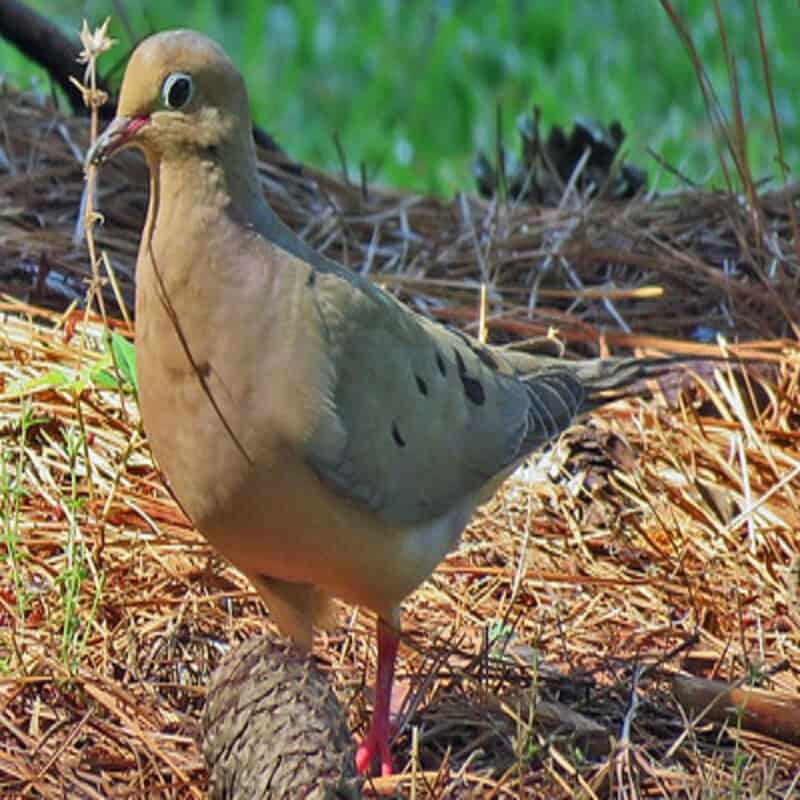The mourning dove, Zenaida macroura is a Columbidae bird. The bird is also known as the American mourning dove, the rain dove, and the turtle dove. It is one of North America’s most common and ubiquitous birds. It is also a popular game bird, with over 20 million birds (up to 70 million in certain years) shot for fun and meat in the US.
Its population can withstand such pressure because it breeds prolifically; in warm places, one couple may rear up to six broods of two young each year. The wings create a peculiar whistling sound while taking off and landing. The bird can fly up to 88 km/h (55 mph).
Quick Overview: Zenaida Macroura – Mourning Dove
Body size: Around 12 in (30 cm) and a weight of 110-170 g (3.88-5.99 oz)
Main colors: Gray-blue, Brown, Black, White, Blue, Red
Range: Throughout the United States
Migratory Bird: Yes
Best time of the year to see in the U.S.: All Year (January – December)
Conservation Status: Least Concern
Mourning Dove Description
Mourning doves are pigeon-sized birds. Their size, weight, and coloring vary. Their bodies are sleek, with a tiny head and a long, pointed tail. Backs are grayish-blue to brown with black dots on wings and behind eyes. The tail has white tips. With a crimson body and a tiny black beak, Males are bigger and brighter than females, with a bluish head and redbreast.

Size
These birds have a length of 12 in (30 cm) and a weight of 110-170 g (3.88-5.99 oz). Their wings could range from 17-19 in (43-48 cm).
Feeding
Seeds, discarded grain, fruit, and insects are all eaten by mourning doves. They like to eat seeds that have fallen on the ground. When ground food is sparse, they will feed in trees and shrubs. Seeds or plant pieces make up the majority of their diet. Mourning doves consume cereal grains including maize, millet, rye, barley, and oats, as well as other agricultural crops. Mourning doves are occasionally seen feasting on grasshoppers, ants, beetles, and snails.
Habitat
Mourning doves are versatile birds that may be found in a broad range of environments. They’re more prevalent around meadows and fields in open woods and forest borders. They thrive in agricultural and suburban regions, where people have built extensive tracts of appropriate habitat.
Behavior
Monogamous mating and migratory patterns of mourning doves are two well-studied traits. Each fall, mourning doves travel south from their nesting areas to a warmer environment for the winter. These birds can travel over 1000 kilometers during migration to reach their wintering grounds. Mourning doves fly quickly and directly.
Zenaida Macroura Scientific Classification
- Kingdom: Animalia
- Phylum: Chordata
- Subphylum: Chelicerata
- Class: Aves
- Order: Columbiformes
- Family: Columbidae
- Genus: Zenaida
- Species: Zenaida macroura
Other common names
The bird is also known as the American mourning dove, the rain dove, and the turtle dove.
Best time of the year to see
In the United States, the best time of year to see these birds is all year round, regardless of the season. This refers to any month of the year between January and December.
Distribution of the Mourning Dove in the USA
Only the Nearctic area is home to mourning doves. They may be found from southern Canada to Panama, as well as across the United States. Mourning doves may be found all year throughout most of their area, although northern populations move south in the winter.
The Mourning Dove can be found in the following states in the United States – Alabama, Alaska, Arizona, Arkansas, California, Colorado, Connecticut, Delaware, Florida, Georgia, Hawaii, Idaho, Illinois, Indiana, Iowa, Kansas, Kentucky, Louisiana, Maine, Maryland, Massachusetts, Michigan, Minnesota, Mississippi, Missouri, Montana, Nebraska, Nevada, New Hampshire, New Jersey, New Mexico, New York, North Carolina, North Dakota, Ohio, Oklahoma, Oregon, Pennsylvania, Rhode Island, South Carolina, South Dakota, Tennessee, Texas, Utah, Vermont, Virginia, Washington, West Virginia, Wisconsin and Wyoming.
